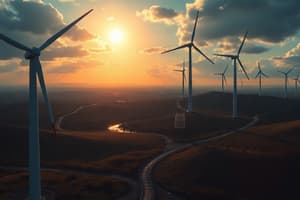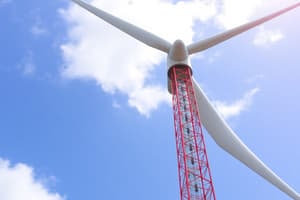Podcast
Questions and Answers
Which component of a wind turbine is responsible for capturing wind energy and converting it to rotational energy?
Which component of a wind turbine is responsible for capturing wind energy and converting it to rotational energy?
- Tower
- Rotor blades (correct)
- Control systems
- Nacelle
What is the maximum theoretical efficiency of a wind turbine known as?
What is the maximum theoretical efficiency of a wind turbine known as?
- Betz Limit (correct)
- Theoretical Limit
- Wind Utilization Ratio
- Efficiency Cap
Why is site selection critical in wind farm design?
Why is site selection critical in wind farm design?
- To ensure turbine size is consistent
- To analyze environmental impact and wind resources (correct)
- To maximize the number of turbines
- To determine turbine color scheme
What role do Renewable Portfolio Standards (RPS) play in energy policy?
What role do Renewable Portfolio Standards (RPS) play in energy policy?
What is one challenge associated with wind power generation systems?
What is one challenge associated with wind power generation systems?
What is typically the recommended spacing between turbines in a wind farm to minimize wake effects?
What is typically the recommended spacing between turbines in a wind farm to minimize wake effects?
Which of the following is a key aspect of integrating wind power into the electrical grid?
Which of the following is a key aspect of integrating wind power into the electrical grid?
What is a common type of wind turbine that typically has three blades?
What is a common type of wind turbine that typically has three blades?
Flashcards are hidden until you start studying
Study Notes
Wind Energy
Wind Turbine Technology
-
Components:
- Rotor blades: Capture wind energy and convert it to rotational energy.
- Nacelle: Houses the generator, gearbox, and other components.
- Tower: Supports the nacelle and rotor, elevating them to capture more wind.
- Control systems: Optimize performance and ensure safety.
-
Types:
- Horizontal-axis turbines (HAWT): Most common, typically three blades.
- Vertical-axis turbines (VAWT): Less common, can operate in turbulent wind.
-
Efficiency:
- Betz Limit: Maximum theoretical efficiency of a wind turbine is 59.3%.
- Factors affecting efficiency: Wind speed, blade design, and turbine placement.
Wind Farm Design
-
Site Selection:
- Wind resource assessment: Analyze average wind speeds and patterns.
- Environmental impact: Consider wildlife, local ecosystem, and noise.
-
Layout:
- Spacing: Turbines spaced to minimize wake effects (typically 5-10 rotor diameters apart).
- Orientation: Align turbines to prevailing wind direction for optimal performance.
-
Grid Connection:
- Proximity to power lines: Reduces transmission losses.
- Integration with local energy infrastructure: Ensures stable supply and demand balance.
Energy Policy
-
Incentives:
- Tax credits: Encourage investment in wind energy projects.
- Renewable Portfolio Standards (RPS): Mandate a certain percentage of energy from renewable sources.
-
International Agreements:
- Paris Agreement: Promotes reducing greenhouse gas emissions, with wind energy as a key component.
-
Regulations:
- Land use and zoning laws: Affect where wind farms can be constructed.
- Environmental regulations: Aim to mitigate impacts on habitats and biodiversity.
Wind Power Generation System
-
Operation:
- Wind kinetic energy is converted to mechanical energy by turbine blades.
- Mechanical energy drives a generator to produce electricity.
-
Grid Integration:
- Connection to the electrical grid to supply generated power.
- Use of energy storage systems (batteries, pumped hydro) to manage supply variability.
-
Challenges:
- Intermittency: Wind availability can be unpredictable.
- Infrastructure development: Requires significant investment in grid enhancements.
-
Future Outlook:
- Technological advancements: Improvements in turbine efficiency and capacity.
- Increased adoption: Growing interest in sustainable energy sources and decarbonization efforts.
Wind Turbine Technology
- Rotor blades efficiently capture wind energy, transforming it into rotational energy for electricity generation.
- Nacelle contains critical components like the generator and gearbox, facilitating electricity conversion.
- Tower heightens turbines to optimize wind capture, enhancing overall energy output.
- Control systems monitor and adjust turbine performance to maximize safety and efficiency.
- Horizontal-axis wind turbines (HAWT) are predominantly used; they typically feature three blades for optimal energy capture.
- Vertical-axis wind turbines (VAWT) can function in turbulent wind conditions, though they are less common.
- Betz Limit represents the theoretical maximum efficiency of a wind turbine, capped at 59.3%.
- Various factors influence turbine efficiency, including wind speed, blade design, and strategic turbine placement.
Wind Farm Design
- Site selection for wind farms requires thorough wind resource assessments to ensure viable average wind speeds.
- Environmental impact studies are essential to evaluate effects on local wildlife and ecosystems, as well as to address noise concerns.
- Turbine spacing is crucial (usually 5-10 rotor diameters apart) to reduce wake effects and improve overall efficiency.
- Configuring turbine orientation in alignment with prevailing wind directions optimizes performance and energy capture.
- Proximity to power lines is important for reducing transmission losses and enhancing grid connectivity.
- Integration with local energy systems is vital for maintaining a consistent supply and demand balance.
Energy Policy
- Tax credits serve as significant incentives to promote investment in wind energy projects.
- Renewable Portfolio Standards (RPS) require that a specific percentage of energy comes from renewable resources, supporting wind energy growth.
- The Paris Agreement fosters international initiatives to reduce greenhouse gas emissions, positioning wind energy as a critical element in this transition.
- Regulations on land use and zoning impact the potential locations for building wind farms, while environmental regulations focus on conserving habitats and biodiversity.
Wind Power Generation System
- Wind kinetic energy is initially converted to mechanical energy by turbine blades, which then drives a generator to produce electricity.
- The system connects to the electrical grid, supplying the generated power to consumers.
- Energy storage solutions, such as batteries or pumped hydro systems, help manage voltage and supply variability due to wind's intermittent nature.
- Challenges include the unpredictability of wind availability and the need for robust infrastructure investment to upgrade grid capabilities.
- The future of wind energy looks promising, with advancements in turbine technology expected to enhance efficiency and capacity, coupled with increased adoption due to a shift towards sustainable energy practices and decarbonization goals.
Studying That Suits You
Use AI to generate personalized quizzes and flashcards to suit your learning preferences.





